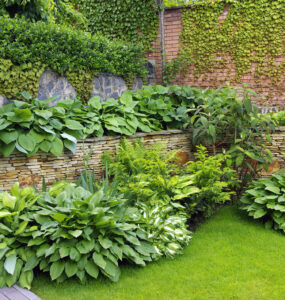Creating a Shady Sanctuary
by Rob Sproule
“A thing of beauty is a joy for ever:
its loveliness increases; it will never
pass into nothingness; but still will keep
a bower quiet for us, and a sleep
full of sweet dreams, and health, and quiet breathing.”
– John Keats, Endymion
As a fresh-faced Undergraduate student, years ago, I poured over the Romantic poets. John Keats, and his unfading wonderment of the natural world, was my favourite.
In Endymion, Keats sets the mood by associating eternal beauty with a peaceful bower (a shady place under trees), where the perfect nap awaits weary travelers. The British Romantics were so inspired by shade-giving trees that they wrote many of their masterpieces while sitting under them.
There’s no shade quite like that from a tree, and a “bower quiet for us” is what comes to many peoples’ mind when they think of a backyard oasis. You don’t need a giant boulevard tree to create a shady sanctuary. The most popular shade trees are those small enough to fit neatly into typical suburban lots.
Shade-giving trees love direct sunlight, which is good because there’s usually nothing able to grow above them! Well-drained soil is best, and the varieties below are all very hardy to our winters. I never recommend planting a big tree that’s only somewhat hardy, as it won’t grow to the size you want and you’ll probably end up replacing it in a few years, anyway.
Mountain Ash
Contrary to the name, the Mountain Ash isn’t related to the Ash trees that probably line your boulevard. Mountain Ash are smaller, peaking at around 10 meters, and have an attractive, segmented leaf shape.
When most trees drop their leaves in the fall and shiver naked in the snow, Mountain Ash keep their berries throughout the winter. All those pictures you’ve seen on the internet of snow piled high on crisp, crimson berries: that’s a mountain ash! The legend goes that the more berries a mountain ash has, the harder the winter ahead will be.
If you’re lucky, the berries may attract a welcome visitor in the early spring. Sky filling flocks of Waxwings regularly visit my yard to feast on the leftover berries. It’s an awesome spectacle as they enjoy the Vitamin C and other fermented goodies (sometimes getting a little tipsy in the process) in the berries.
Linden
For a classic shade-giving tree, you can’t beat a Linden. Growing into a stately, densely shaped pyramid of dark green, heart shaped leaves, Lindens are big trees that can top 15 meters high.
Given their size, Lindens provide a ready-made shady bower under their lower canopy. It yields hanging clusters of fragrant yellow flowers in the early summer and you won’t need to spend your fall days picking up fruit. The large leaves turn a heart-warming, rich yellow in the fall.
Schubert Chokecherry
Although it’s technically a choke-cherry, I wouldn’t recommend eating Schuberts’ fruit. Instead, enjoy this relatively small (7-8 meters high at maturity) tree for it’s striking burgundy foliage and delicate white spring flowers.
Schuberts are perfect ideal for people with smaller yards. They’re compact (as trees go), don’t drop a bunch of messy fall fruit, and provide a perfectly secluded bower to sit under.
The only time I wouldn’t recommend a Schubert is if you have a lot of black knot fungus (it looks like burnt sausage links wrapped around your tree) in your area. The tree is very susceptible to this fungus, and it’s very common in established neighbourhoods.
–
















